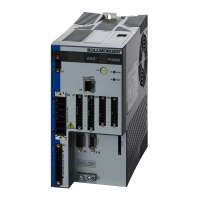AKD User Guide | 10 Configuring General Drive Settings
10.1 Digital Inputs and Outputs
10.1.1 Overview
The drive has programmable digital inputs and outputs that you can use to initiate motion, control auxiliary
devices, or trigger other actions. The inputs and outputs should be wired according to the instructions in the drive
Installation Manual. Note that the input on pin 4 of the X8 connector is dedicated as an enable input.
10.1.2 Using Digital I/O
Once wired correctly, digital inputs and outputs can be used for a variety of functions such as to trigger auxiliary
devices, initiate homing moves or other motion tasks, or set travel limits. This section describes the specific func-
tionality of the programmable I/O.
I/O Tip: When using I/O devices, you must carefully consider the type of device you use for switches. An unsuit-
able switch can cause switch bounce, which in turn can cause erroneous triggers to occur. For example a low
cost xx switch, as it is toggled, will bounce a few times before it turns on or off. A device that is monitoring these
inputs frequently may interpret the bounce as multiple triggers of that I/O. The drive has the ability to reduce this
type of error using some debounce techniques to ignore sudden state changes caused by bounces.
10.1.3 Digital Inputs
Digital inputs can be set in different modes based on the desired function. These functions are outlined below:
Mode 0: Off
This mode is the non-use state. The drive defaults to this setting.
Mode 1: Fault Reset
This mode is used to clear the drive faults. A change in state causes the drive to reset faults. This mode will only
correct non-fatal faults (see fault chart). Upon a rising edge a command, which is similar to DRV.CLRFAULTS,
is issued and faults are cleared.
Mode 2: Start Motion Task
This mode is used to start motion task number X. This input will trigger a motion task number as defined in the
extra parameter field for this input.
X = the value of the associated input parameter.
It is assumed that motion task number X exists.
Example:
-->DIN1.MODE 2 - sets the input mode to be Start Motion Task
-->DIN1.PARAM 1 - sets the Motion Task to start to be 1.
-->MT.LIST - confirms that Motion Task 1 exists.
-->10.000 [counts] 1000.000 [rpm] 0 1001.358 [rpm/s] 1001.358 [rpm/s] 0
0 0 [ms]
<Create a rising edge of the input>
<Motion Task 1 executed>
Mode 3: Motion Task Select Bit
This mode is used to select the motion tasks that are stored in the drive (numbers 1 to 127) or the reference trav-
erse/homing (0). The motion task number is presented externally at the digital inputs. The motion task set by this
mode will be executed when digital input assigned to mode 4 (motion task start selected) gets a rising edge.
Example
Assume:
DIN1.MODE = DIN2.MODE
84 Kollmorgen | December 2010

